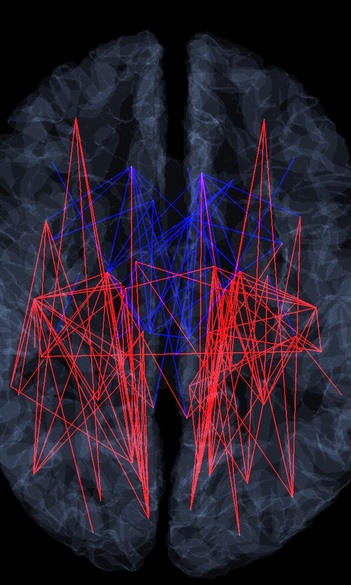Male edges, female edges
The analysis of large graphs is often focused on the identification of important vertices within the graph. Pioneering work in this area was carried out by the founders of Google, who classified the vertices determined in the World Wide Web according to their importance. They used a metric called PageRank and displayed the important results in the hit list. Among other things, this procedure contributed to the success of Google.
Every network can be described by a graph consisting of vertices and edges between them. So far, the identification of important edges – instead of important vertices – in large graphs has received little attention. Members of the ELTE PIT Bioinformatics Group – László Keresztes, Evelin Szögi, and Bálint Varga – supervised by Professor Vince Grolmusz, have now identified brain edges (i.e. connections) from the weight of which they could infer the sex of the subjects.
The researchers created braingraphs based on a large American MRI dataset from 1,200 subjects by
connecting the vertices of brain areas with edges,
if nerve fibres could be identified between them on the MRI scans. The edges were characterised by the number (that is, the thickness) of the nerve fibres defining them.
The research group found that if certain edges comprised more nerve fibres than a given number – in other words if the weight was larger than the “c” cut-value –, the subject was more likely to be male, and if there were fewer fibres in them, the subject was often female. Such edges were called ‘male implicator edges’. On the other hand, there were also edges that were normally thicker in women, and were thus named ‘female implicator edges’.
This is the first discovery to demonstrate that the properties of single braingraph edges can be used for gaining important biological implications. This is also important because if we can infer a property from single connections, then that connection is essential from the aspect of that property. This finding allows us to identify brain connections that are related to certain biological properties. The identification may be fundamental in evaluating the consequences of cerebral traumas, stroke, brain tumours, and developmental disorders.
More surprisingly, the male and female implicator edges defined above are located in different parts of the brain. The female implicator edges tend to be intra-hemispheric connections (red edges in the figures), whereas the male implicator edges are mainly inter-hemispheric ones (blue edges). The male implicator edges are mostly located in the anterior areas of the brain, and those implying the female sex are more frequent in the posterior regions of the brain. (The former can be observed on the outer cover image and the latter on the inner image.)
The article was published in Neuroscience Letters and can be accessed free of charge from this link.
Photos and video by Bálint Varga

